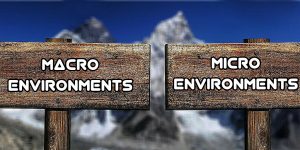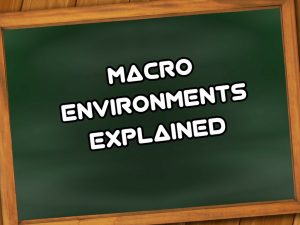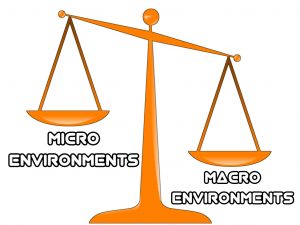Differences Between Micro and Macro Environment: Every company is a component of the business environment in which it conducts its operations. No entity can operate in a vacuum since it is surrounded by a variety of circumstances, known as a business environment, that are either nearby or far away. It may be roughly divided into two groups, namely macro and micro environments. While the latter has an impact on all business entities operating in the economy, the former only has an impact on the operation of the specific firm to which they are related.

While the macro environment is a broad business environment that has an overall impact on all business units, the micro environment has a direct impact on company operations. To comprehend how different factors affect company, it is crucial to understand the business environment. Read the provided article to learn the distinction between a macroenvironment and a microenvironment.
Recommended: How to make reading interesting for students
Micro-environment Explained
Microenvironment is the term used to describe an environment that is in close proximity to a business organization and has the potential to immediately impact those organization’s daily operations. It is related to the company’s limited geographic region of operation.

All the forces that are near to the company make up the microenvironment. These forces only apply to the aforementioned firm. For a limited period of time, they can affect the company’s performance and daily operations. Its components include vendors, rivals, marketing middlemen, clients, and the company itself.
It comprises of several factors that are unique to a given firm and have the ability to impact everyday operations and performance for a limited time. These forces or elements include, among others, suppliers, shareholders, clients, workers, rivals, and the media.
a. Suppliers: These give firms access to resources including raw materials, tools, and other equipment. As they offer the essential production inputs, their actions may have an influence on the organization’s strategy. In the dearth of prompt and competent services, the manufacturing process may stall, adding to the amount of time needed for production and decreasing revenues.
Recommended: Oldest cities in the world currently
b. Customers: Customers are the ultimate recipients of goods or services since they are the monarch of any firm. They are essential to every business since they bring in more clients, which increases income.
As a result, an organization’s marketing strategy must be centered on retaining current consumers and luring new ones by meeting their requirements and preferences. Increased value-added services and after-sales support are also crucial for growing the clientele.
b. Competitors: Corporate rivals or competitors can have a direct impact on business strategies. Therefore, doing a competitive analysis of rivals is essential to gaining a competitive edge.
This study must include knowledge of each competitor’s USP (unique selling point) for the goods and services they provide. A company may also maintain its competitive edge by providing goods or services that are superior to those of rivals.
c. Employees: Through the use of qualified staff members who are also subject-matter experts, organizations may accomplish their goals.
Organizations may guarantee success by selecting the best personnel and giving them appropriate opportunity for training and growth.
Also see: Secrets to a successful marriage
d. Shareholders: Investors in a firm who also own shares of it are referred to as shareholders. They get ownership in the firm in this way. In the end, they are entitled to a return on their portion of the investment. This makes businesses obligated to distribute advantages derived from earnings to them.
Dividend payments are another way that businesses maintain shareholder interest. Therefore, it is crucial for the organization to strike the correct balance between its own interests and those of its shareholders.
e. Media: Additionally, media outlets are crucial in how businesses promote themselves. For every business to effectively market its goods and services, media is now a must. Therefore, it is necessary for organizations to retain a positive reputation and relationship with the media.
A poor public reputation for the firm might cause significant losses. Because of this, businesses now have a specialized PR (public relations) department to manage media-related tasks efficiently and effectively. Additionally, in order to foster a favorable brand image among their audience or customers, firms must develop new ways to connect with them.
Recommended: Tips to Overcome Inferiority complex
Macro Environment Explained
The macro environment is the overall economic context that simultaneously affects how each company sector operates, performs, makes decisions, and formulates a plan. It has a vibrant quality. Consequently, it is ever-changing.
It consists of external influences that are not in the business’s control yet have a significant impact on how the firm operates. It consists of the people, teams, associations, businesses, and other entities that the company interacts with over the course of its operations.

PESTLE Analysis is the name for the study of the macroenvironment. PESTLE stands for the environmental variables, which include political, economic, sociocultural, technological, legal, and environmental factors.
These variables take into account both economic and non-economic elements, including social issues, governmental regulations, family structure, population size, inflation, features of the GDP, income distribution, ethnic diversity, political stability, taxes, and duties, among others.
Recommended: Countries With Lowest Divorce Rate in the World 2022
Key Differences Between Micro Environment and Macro Environment
1. Definition: The term “micro-environment” describes an environment that is in close proximity to a business organization and has the potential to directly affect those operations. It is described as the immediate environment in which the company does business. Macro environment is the general economic environment that affects all corporate organizations’ operations, output, decision-making, and policy at the same time. It alludes to the general setting that has the potential to affect how all commercial organizations operate.

2. Area: In addition to being recognized as the internal environment, the microenvironment is sometimes referred to as the exterior environment. A firm’s internal components make up a small and constrained microenvironmental region.
A macro environmental region is larger and more widely dispersed, and it contains both internal and external elements that affect businesses.
3. Effect: Microenvironment does have a direct impact on the particular group or business.
Each and every corporate entity is impacted by the macro environment, not just one in particular.
Recommended: Most Capitalist Countries in the World 2022
4. Elements: Competitors, suppliers, the organization itself, the market, and middlemen are microenvironment components.
Population and demographic, economic, sociocultural, technological, legal & political, and environmental factors make up the macro environment.
5. Business process: The microenvironment directly affects the organization. It comprises customers and clients, as well as other regional players, suppliers with direct or indirect contracts, and consumers.
The macro environment is made up of all variables that can influence an organization but are beyond its direct control. Typically, a business does not violate any laws. The business must be adaptable since it is always evolving.
Recommended: How to differentiate between love and lust
Other differences include:
a. The environment that directly interacts with a company is known as the micro environment. The environment that is not distinctive to a single company but has the power to affect how each and every business group functions is referred to as the macro environment.
b. The macro environment is the outside world, whereas the micro environment is the business’s internal environment.
c. Only the specific business is impacted by the microenvironmental elements, but all business entities are impacted by the macroenvironmental factors.
d. The company can influence the micro environmental aspects, but it cannot influence the macro environmental factors.
e. In contrast to the Macro Environment, the Micro Environment’s components immediately and frequently influence the company.
f. The term “COSMIC analysis” refers to the study of the microenvironment. PESTLE Analysis, on the other hand, examines the macroenvironment.
Recommended: Differences Between a business man and an entrepreneur
Conclusion
The organization’s development, success, and continued existence are significantly influenced by both the micro and macro environments. Both are complimentary even if they are distinct from one another. An organization may develop a marketing strategy by doing a SWOT (strength, weakness, opportunity, and threat) analysis of its firm by researching these environmental aspects.

Edeh Samuel Chukwuemeka, ACMC, is a lawyer and a certified mediator/conciliator in Nigeria. He is also a developer with knowledge in various programming languages. Samuel is determined to leverage his skills in technology, SEO, and legal practice to revolutionize the legal profession worldwide by creating web and mobile applications that simplify legal research. Sam is also passionate about educating and providing valuable information to people.